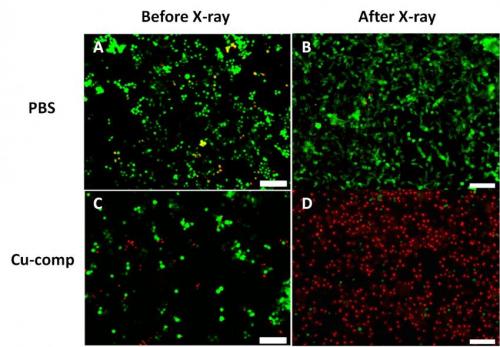
A University of Texas at Arlington physicist working to create a luminous nanoparticle to apply in security-related radiation detection may have instead fell upon an advance in photodynamic cancer therapy.
Professor of physics and co-director of UT Arlington's Center for Security Advances Via Applied Nanotechnology, Wei Chen , was testing a copper-cysteamine complex created in his lab when he found unexplained decreases in its luminescence, or light emitting power, over a time-lapse exposure to X-rays. Delving deeper into the matter, he discovered that the nanoparticles, called Cu-Cy, were losing energy as they released singlet oxygen, a toxic byproduct that is used to damage cancer cells in photodynamic therapy.
Because Chen also is leading federally funded cancer research, he knew he had discovered something extraordinary. Testing showed that the Cu-Cy nanoparticles, in combination with X-ray exposure, drastically slowed tumor growth in lab studies.
"This new idea is simpler and better than previous photodynamic therapy methods. You don't need as many steps. This material alone can do the job. It is the most promising thing we have found in these cancer studies and we've been looking at this for a long time," said Chen.
Chen's research is set to be published in the August edition of the Journal of Biomedical Nanotechnologyunder the title "A New X-Ray Activated Nanoparticle Photosensitizer for Cancer Treatment." Co-authors are Lun Ma, a research assistant professor, and Xiaoju Zou, a research associate.
The University has also filed an interim copyright application on the new endeavor.
Photodynamic therapy, or PDT, hurts cancer cells when a photosensitizer introduced into tumor tissue generates toxic singlet oxygen after being exposed to light. In some studies, this light exposure is performed via use of visible or near-infrared lasers. Other studies have found additional success by also introducing luminescent nanoparticles into the tumor. Researchers activate the luminescent nanoparticle with near-infrared light or X-rays, which in turn activates the photosensitizer.
Both techniques have their disadvantages for treating deep tissue cancers. They are either inept or the light source needed to activate them doesn't penetrate deep enough. Chen notes that X-ray inducible Cu-Cy particles are far superior to current photosensitizers because the X-rays can penetrate deep into tissue. Additionally, Cu-Cy nanoparticles don't need other photosensitizes to be effective so the treatment is more convenient, efficient and cost-effective.
"Dr. Chen's commitment to his work in cancer-related therapy, as well as his work in the area of homeland security, demonstrates the wide-ranging applications and great value of basic science research. These advances have the potential to change the way some cancers are treated and make therapy more effective - a benefit that would be boundless," said vice president for research at UT Arlington, Carolyn Cason.
Chen's team tested the Cu-Cy on human breast and prostate cancer cells in the lab and found it to be a useful and effective treatment when combined with X-ray exposure. In one test, for instance, a tumor treated with Cu-Cy injection and X-ray exposure stayed virtually the same size over a 13-day period while a tumor without the full treatment grew by three times.
Another benefit of the new nanoparticle is a low toxicity to healthy cells. Furthermore, Cu-Cy's intense photoluminescence and X-ray luminescence can be used for cell imaging, according to the paper.
Details of the crystal structure and optical properties of the new complex are being published in an upcoming paper from the Journal of Materials Chemistry. Chen continues to pursue photodynamic cancer therapy research under a grant from the Department of Defense Congressionally Directed Medical Research Programs and with collaborations from industry. He said further research would include reducing the size of the Cu-Cy nanoparticle to make it more easily absorbed in the tumor tissue.
"For cancer, there is still no good solution yet. Hopefully this nanoparticle can provide some possibilities," he said.










